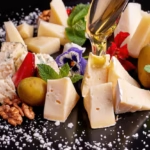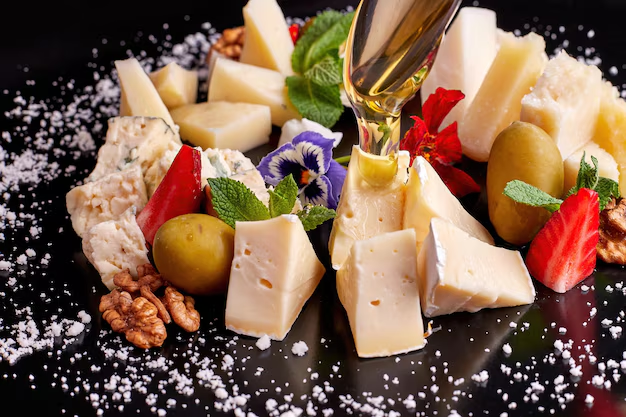In the expansive world of cheese, some varieties define comfort—cheddar melting on toast, mozzarella stretching across pizza—and then there are cheeses that belong in the realm of discovery. Grouse Cheese falls squarely into the latter category. It is not just something to eat; it is an artisanal journey, a taste of landscapes that are as wild as they are beautiful. Steeped in heritage, born from demanding climates, and shaped by the hands of multi-generational cheesemakers.
Grouse cheese offers a sensory experience unlike any other. Its story is one of resilience, environmental harmony, and a steadfast commitment to tradition.
The Origin Story of Grouse Cheese
The roots of Grouse cheese stretch deep into the rugged highlands of Europe. This is not a cheese born in bustling markets or industrial dairies; instead, it is a product of isolated alpine and moorland communities where survival depended on resourcefulness. Historically, shepherds tended small flocks of sheep and goats, grazing them on hillsides rich in wild herbs, lichen, and grasses. The name “Grouse” comes not from its ingredients but from the grouse bird, a hardy creature that inhabits the same landscapes. The environments were often remote—Scotland’s Cairngorms, the French Vosges, Italy’s.
Trentino-Alto Adige, rural Slovenia, and southern Austria—where transporting fresh milk was nearly impossible. Cheesemaking became the logical solution, turning perishable milk into a durable, transportable, and nourishing product. Cheesemakers worked with what they had: raw milk, wild rennet sources like thistle or nettle, simple tools, and natural aging spaces like caves or root cellars. The results were small, intensely flavored wheels that spoke of the place they came from.
Characteristics That Set Grouse Cheese Apart
Grouse cheese stands out in the world of artisanal dairy not only because of its flavor but also due to its distinctive production practices. These unique elements ensure that no two wheels are exactly alike.
1. Raw Milk Heritage
Traditional Grouse cheese is crafted exclusively from raw milk. This choice preserves the natural microbial life within the milk, creating deep complexity in taste and a strong connection to terroir. Pasteurization, common in industrial cheesemaking, is avoided to keep these subtle characteristics intact.
2. Diet of Foraged Fodder
The animals that provide the milk are not factory-farmed. They graze freely on diverse, uncultivated pastures filled with alpine herbs, mosses, and heather. This biodiverse diet infuses the milk—and consequently the cheese—with earthy, floral, and herbal nuances that cannot be replicated in controlled feed environments.
3. Natural Rind and Slow Aging
Grouse cheese develops a natural rind during the maturation process, often brushed with brine or rubbed with peat ash. The rind’s rustic, sometimes cracked appearance is a visual testament to the slow, deliberate aging process, which can range from three months for a young cheese to over eighteen months for an aged reserve.
4. Limited, Seasonal Production
Small-scale production is a hallmark of Grouse cheese. Many cheesemakers produce fewer than 500 wheels per season. The focus remains on craftsmanship rather than volume, ensuring each wheel receives the attention it deserves.
A Table of Grouse Cheese Attributes
| Attribute | Description |
|---|---|
| Milk Source | Raw sheep’s milk or a blend of sheep and goat milk |
| Geographical Origin | Highland and moorland regions of Europe |
| Aging Period | 3 months (young) to 18+ months (aged reserve) |
| Flavor Profile | Earthy, herbal, nutty, with subtle smokiness |
| Texture | Supple and elastic when young, crumbly and dense when aged |
| Production Scale | Small-batch, seasonal |
| Diet of Animals | Wild herbs, lichen, moorland grasses |
| Rind Type | Natural, often ash-brushed or brine-washed |
The Flavor Experience
Describing Grouse cheese to someone who has never tasted it can be challenging. Its flavors are layered and evocative, with earthy depth that recalls moss-covered forest floors, herbal brightness from wild grazing lands, and an occasional hint of peat smoke carried on highland winds.
Younger wheels tend to be mellow, pliable, and creamy, ideal for melting or folding into recipes. Aged varieties, by contrast, become intense, crumbly, concentrated, and slightly sharp, with lingering nutty undertones. The taste can conjure images of autumn walks in the mountains or the scent of wildflowers after rain.
How Grouse Cheese Is Made
The making of Grouse cheese is as much an art as it is a craft. Though slight variations exist between regions and producers, the core process remains deeply traditional.
Milking and Filtering – Milk is collected fresh at dawn, hand-filtered through cloth, and used immediately without chilling to preserve its living cultures.
Curdling – Natural rennet, often derived from plants like thistle or nettle, is added to the milk. In cooler climates, this coagulation stage can take up to 12 hours.
Cutting and Pressing – The curds are cut gently to release whey, then pressed into cloth-lined molds. Some cheesemakers use traditional stone weights to apply pressure.
Salting and Brining – Wheels are either soaked in whey brine or dry-salted, sometimes with additions like crushed juniper berries or yarrow for subtle aromatics.
Aging – The cheeses are aged on wooden shelves in caves, cellars, or cool rooms. They are turned regularly and occasionally brushed with brine or ash to encourage proper rind development.
Culinary Uses: Beyond the Cheese Board

While Grouse cheese is a delight eaten on its own, it also excels in cooking. Its meltability and depth of flavor make it a versatile ingredient for rustic and refined dishes alike.
- Melted into gratins of root vegetables or potatoes
- Shaved over wild mushroom risotto
- Folded into polenta for richness
- Paired with crusty sourdough bread and wild berry preserves
- Incorporated into artisanal breads or savory pastries
- Served alongside smoked or cured meats for a charcuterie experience
Modern chefs have also explored its use in innovative culinary contexts, transforming it into foams, gelées, or fermented crumbles for avant-garde presentations.
Availability and How to Find It
Sourcing authentic Grouse cheese can be a quest in itself. Because production is small-scale and seasonal, it is rarely available in mainstream supermarkets. Your best chances of finding it include visiting farmers’ markets in highland regions, exploring specialty cheesemongers in European cities, or checking select gourmet shops in places like London, Berlin, or San Francisco. Online platforms dedicated to artisanal foods may occasionally offer small quantities for shipment, though availability is often limited.
Storing and Serving Grouse Cheese
Wrap the cheese in breathable materials like cheese paper or waxed cloth—avoid plastic, which traps moisture and encourages spoilage. Keep it in the vegetable drawer of your refrigerator or, ideally, in a dedicated cheese storage box. Allow the cheese to come to room temperature for about 30 minutes before serving; this unlocks its full aromatic and flavor profile.
Cultural Significance
In the rural highlands where it originates, Grouse cheese holds more than just gastronomic value. It plays a role in community traditions and is sometimes given as a gift during weddings, births, or seasonal festivals. In folklore, it is a symbol of resilience and humble abundance—stories tell of hidden wheels of cheese sustaining entire villages through hard winters.
Its continued production supports local economies and sustains agricultural traditions that might otherwise vanish in the face of industrialized food systems.
Modern Challenges and Preservation Efforts
Grouse cheese faces a number of threats, including climate change, which alters the fragile ecosystems that feed grazing animals, and the aging demographics of cheesemakers, many of whom are over sixty. Regulatory pressures on raw milk products further complicate its survival.
To counter these challenges, food heritage organizations are working toward securing Protected Designation of Origin (PDO) status for Grouse cheese. Such recognition could protect the traditional methods and guarantee authenticity in the marketplace.
Conclusion
Grouse cheese is more than just a rare dairy product—it is a living expression of landscape, climate, and human dedication. Every bite tells a story that spans generations, from the highland pastures to the rustic cellars where it matures. Its scarcity only enhances its appeal, making it a true treasure for those lucky enough to taste it. Whether enjoyed on a cheese board with natural wine, melted into a comforting dish, or savored alone, Grouse cheese offers an experience that connects us to tradition and the beauty of place.
The Future of Fast Food: Exploring the Pizza Vending
FAQs
1. Is Grouse cheese made from grouse or contain any meat?
No. Grouse cheese contains no meat or bird products. Its name comes from the grouse bird’s highland habitat, which is also where the milk-producing animals graze.
2. What milk is used to make Grouse cheese?
It is usually made from raw sheep’s milk, though some versions use a blend of sheep and goat milk. The animals graze on wild herbs, grasses, and lichen, giving the cheese its distinct flavor.
3. How does Grouse cheese taste?
Grouse cheese has an earthy, herbal profile with subtle smoky notes. Young cheeses are mild, creamy, and elastic, while aged varieties develop a sharper, nuttier, and more crumbly texture.
4. Is Grouse cheese available outside of Europe?
Yes, but in very limited quantities. Small batches are sometimes exported to specialty cheesemongers in cities like London, Berlin, and San Francisco, though it is mostly sold within its regions of origin.
5. Can Grouse cheese be used in cooking, or is it best for cheese boards?
Both. It shines on a cheese board alongside bread, fruits, and wine, but it also melts beautifully in dishes like gratins, risottos, and rustic breads.









